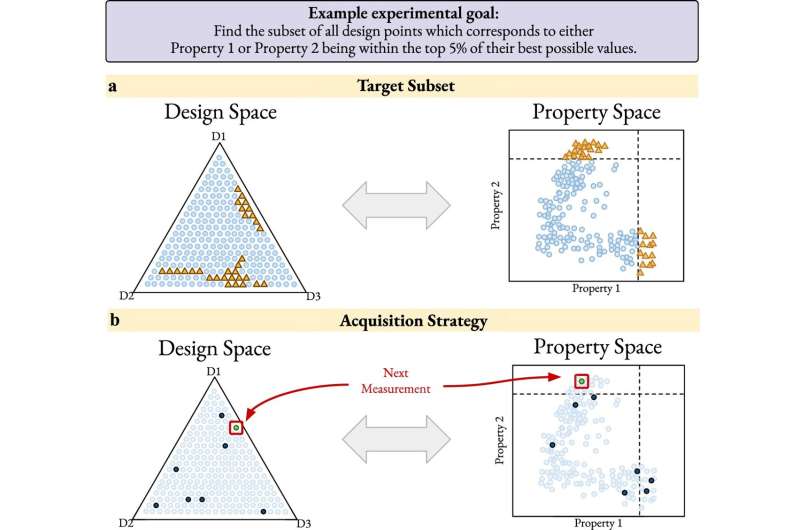This article has been reviewed according to Science X's editorial process and policies. Editors have highlighted the following attributes while ensuring the content's credibility:
fact-checked
peer-reviewed publication
trusted source
proofread
New AI approach accelerates targeted materials discovery and sets the stage for self-driving experiments

Scientists have developed an AI-based method that helps gather data more efficiently in the search for new materials, allowing researchers to navigate complex design challenges with greater precision and speed.
This research originated from a collaboration between computer science and materials science researchers at the Department of Energy's SLAC National Accelerator Laboratory and Stanford University. The collaboration combines expertise in algorithm development, machine learning and materials science.
Their work, published today in npj Computational Materials, lays the foundation for "self-driving experiments," where an intelligent algorithm defines the parameters for the next set of measurements at facilities such as SLAC's Linac Coherent Light Source (LCLS). The new method also allows for the rapid discovery of new materials, which may show promise in fields such as climate change, quantum computing and drug design.
Traditional materials discovery has historically been a time-consuming and expensive process due to the cost of both making and measuring the properties of new materials. The space of possible materials is also extremely large, in excess of 10 billion possibilities for materials with just four elements. For pharmaceutical applications, the challenge is even greater—with about 1060 possible drug-like molecules containing only the most basic building blocks (C, H, O, N and S atoms).
The task is further complicated by the need to satisfy complex design goals, such as discovering conditions to synthesize nanoparticles with different sizes, shapes and compositions. Traditional methods, which typically maximize or minimize a simple property, are often too slow to sift through vast search spaces to discover new materials that match a researcher's goals.
This paper proposes a new approach that takes complex goals and automatically converts them into intelligent data acquisition strategies. A key feature is the ability to learn and improve from each experiment, using AI to suggest the next steps based on the data collected so far. The innovation is based on the concept of Bayesian algorithm execution (BAX), developed recently by co-author Willie Neiswanger, who was a postdoctoral fellow in computer science at Stanford at the time the research was conducted. In this method, a complex goal can be written as a simple shopping list or recipe, excelling in situations where multiple physical properties need to be considered.
Another important aspect is that this method is user-friendly and open-source, allowing scientists worldwide to use and adapt it for their research, promoting collaboration and innovation globally.
The researchers tested their approach on a variety of custom goals for nanomaterials synthesis and magnetic materials characterization. The results showed that their methods were significantly more efficient than current techniques, especially in complex scenarios.
"Our method allows you to specify complex objectives, enabling automatic optimization over a large design space, which increases the likelihood of finding new, amazing materials," said Sathya Chitturi, a Ph.D. student at SLAC and Stanford who led the research. "The Bayesian algorithm execution framework lets you capture the intricacies of materials design tasks in an elegant and simple way."
The ability to design materials with specific catalytic properties, for example, could improve chemical processes that lead to more efficient and sustainable ways to manufacture goods and materials, reducing energy consumption and waste. In manufacturing, new materials could enhance processes such as 3D printing, allowing for more precise and sustainable production. In health care, tailored drug delivery systems can improve the targeting and release of therapeutics, enhancing efficacy and reducing side effects.
The researchers are already implementing ways to integrate this framework into experimental and simulation-based research projects to demonstrate its wide applicability and effectiveness.
"The project is a great example of multi-disciplinary collaboration between SLAC and Stanford," said collaborator Daniel Ratner, head of SLAC's machine learning initiative (MLI). "Sathya was able to adapt Willie's core algorithmic computer science research to address real-world scientific problems in materials science."
MLI researchers are now looking into applications for large-scale materials simulations, and Neiswanger, Ratner and collaborators just published a related application of BAX to optimize the performance of particle accelerators.
"By combining advanced algorithms with targeted experimental strategies, our method makes the process of discovering new materials easier and faster," said collaborator Chris Tassone, Materials Science Division director for the Stanford Synchrotron Radiation Lightsource (SSRL) at SLAC. "This can lead to new innovations and applications in many industries."
More information: Sathya R. Chitturi et al, Targeted materials discovery using Bayesian algorithm execution, npj Computational Materials (2024). DOI: 10.1038/s41524-024-01326-2
Journal information: npj Computational Materials
Provided by SLAC National Accelerator Laboratory





















